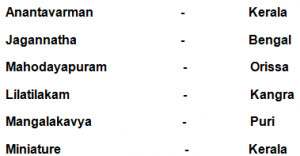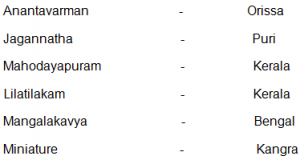NCERT Solutions for Class 7 History Chapter 9 – The Making of Regional Cultures (Social Science), contains solutions to various questions in Exercise for Chapter 9. At the end of the Solutions, all the keywords and Notes which are important to understand From The Making of Regional Cultures Class 7 History, have been explained in a simple and easy to understand manner. NCERT Solutions for Class 7 Social Science help to check the concept you have learnt from detailed classroom sessions and application of your knowledge.
| Category | NCERT Solutions for Class 7 |
| Subject | History (Social Science) |
| Chapter | Chapter 9 – The Making of Regional Cultures |
Download NCERT Solutions for Class 7 History Chapter 9 – The Making of Regional Cultures
NCERT Solutions for Class 7 History Chapter 9 – The Making of Regional Cultures – NCERT Exercises
Question 1:-
Match the following

Answer 1:-

Question 2:-
What is Manipravalam? Name a book written in that language.
Answer 2:-
The book named ‘Lilatilakam’ deals with grammar and poetics and was composed in the language of Manipravalam (diamonds and corals) referring to two different languages, Sanskrit (Devnagri script) and the regional language of Kerela Malayalam (Brahmic script).
Question 3:-
Who were the major patrons of Kathak?
Answer 3:-
- The term Kathak is derived from the Sanskrit word ‘katha’, denotating story. The Kathaks were originally ‘a caste of storytellers’.
- Kathak evolved into a distinct dance with the onset of bhakti traditions. The rasaleela combined elements of storytelling and dance.
- Under the Mughal emperors Kathak became a court dance and developed a distinct style because of constantsupport.
- The dance developed into two schools or gharanas, Lucknow and Jaipur.
- Under Wajid Ali Shah, the last Nawab of Lucknow, Kathak received major support and grew into a major art form.
Question 4:-
What are the important architectural features of the temples of Bengal?
Answer 4:-
- Temple and other religious structures were constructed by individuals or groups who were powerful and instructed the low social groups to do so.
- Most of the modest brick and terracotta temples were built by people belonging to “low” social groups.As their social and economic position enhanced, they broadcasted their status through the construction of temples.
- Temples came to be built on the double roofed and four roofed (dochala and chauchala) structures.
- In chauchala, four triangular roofs were placed on the four walls converge on a curved line or a point to obtain the structure.
- Temples were also built on a square platform. They were decorated with paintings, ornamental tiles and terracotta tablets.
Question 5:-
Why did minstrels proclaim the achievements of their heroes?
Answer 5:-
- Stories portraying the bravery deeds of Rajput heroes were recorded in the form of poems and songs which were recited by specially trained minstrels.
- These poems and songs preserved the memories of heroes and were expected to inspire others especially the common people to take motivation.
Question 6:-
Why do we know much more about the cultural practices of rulers than about those of ordinary people?
Answer 6:-
- We know much more about the cultural practices of rulers compared to that of ordinary people because they were patrons of art.
- The art that the rulers utilized glorified the rule of these kings and emperors.
- These arts like miniatures and biographies were in turn much better preserved than the art and stories left behind by ordinary masses.
- The biographies and poems that were sung for the rulers were meant to affirm the future generations about the magnitude of the ruler.
- Ordinary people did not create stories and poems for future generations.
Question 7:-
Why did conquerors try to control the temple of Jagannatha at Puri?
Answer 7:-
- The temple at Puri grew as an important religious center especially for the purpose of pilgrimage and attracted people from all over the world. Hence the increasing popularity and demandmade this temple a very attractive center for rulers to conquer the temple.
- Rulers such as Anangabhima III dedicated the kingdom to Lord Jagannatha and declared himself as the “deputy” of the God.
- As the temple became gained importance, its authority on social and political matters graduallyamplified.
- All those who gained and conquered Orissa extended control over the temple which in turn legitimized and sanctioned their rule.
- This made the ruler acceptable in the eyes of his subjects.
Question 8:-
Why were temples built in Bengal?
Answer 8:- Take clue from the initial portion on the temple structure in Bengal and develop the answer. (Question 4)
Question 9:-
Describe the most important features of your region, focusing on building, performing arts and paintings.
Answer 9:-
For the answer, any particular state or region can be chosen and its features can be described. Creative answer can be modified by students accordingly.
For example, Kerala. The building in Kerala are traditional buildings which have baked tile roofs with several rooms surrounding an open central courtyard. Houses have plants like Tulsi in this courtyard. The painting style follows a mural style called the Kerala mural which depicts tales from the Puranas and the epics. The performing arts include dances like Kathakali and Mohiniyattam which depict stories from the Puranas and epics.
Question 10:-
Do you use different languages for a) speaking, b) reading, and c) writing? Find out about one major composition in the language that you use and discuss why you find it interesting.
Answer 10:-
Yes, in this day and age we often use a number of languages for speaking, reading and writing. In my surroundings,we use the local languages like Hindi or other mother tongues for speaking. Reading activities are generally undertaken in both Hindi and English and the same applies for writing.
One composition in Hindi that I find interesting is the Ramcharitamanas, which was written in Awadhi dialect. The composition beautifully portrays the concepts ofmagnificence and devotion in terms of words.
Question 11:-
Choose one state from north, west, south, east and central India. For each of these, prepare a list of foods that are commonly consumed, highlighting any differences and similarities that you notice.
Answer 11:-
The north east and southern part of the country rely more on rice-based foods and fermented foods and often these are given the status of staple foods in these regions. While in the North East its fermented bamboo shoots and pork are eaten together with rice making it one of the most liked dish in the states. In south India rice is fermented to make idlis and dosa and dal is used to make vadas. On the other hand,the north and west of the country rely more on wheat-based diet. The wheat is used to make a variety of foods like rotis, pooris and other types of breads.
Question 12:-
Choose another set of five states from each of these regions and prepare a list of clothes that are generally worn by women and men in each. Discuss your findings.
Answer 12:-
Tamil Nadu- Veshti for men and Kanjeevaram sarees for women
Bengal- Dhoti for men and Bengali jamdani sarees for women
Uttar Pradesh- Lucknowi and chikankari based kurtas and sarees
Kerala- Veshti for men and Kasavu saree for women
Assam- They use brightly made shawls known as Mekhla’s that are draped like sarees.
Topics Covered in Chapter 9 – The Making of Regional Cultures Class 7 History (Social Science)
- The Cheras and the Development of Malayalam
- Rulers and Religious Traditions: The Jagannatha Cult
- The Rajputs and Traditions of Heroism
- Beyond Regional Frontiers: The Story of Kathak
- Painting for Patrons: The Tradition of Miniatures
- A Closer Look: Bengal
- The Growth of a Regional Language
- Pirs and Temples
- Fish as Food
Important Terms Relevant for NCERT Solutions for Class 7 History Chapter 9 – The Making of Regional Cultures :
Classical- The word here refers to the dances that are seven in number. These dances are called classical because they require special training as opposed to the folk dances that can be performed by anyone.
Miniature- Miniatures are a form of painting that developed under the Mughals. The miniatures are small paintings that were used in the chronicles and lacked perspective.
Pir- Pir means a religious teacher, often a Sufi master.
Dialect- Dialects are the various forms of speaking the same language. For example, Hindi sounds different in different regions
NCERT Solutions for Class 7 History (Social Science)